|
| |
An important and rare Laurencekirk Scottish tea chest by
C. Stiven having wooden hinges to both the chest and the
lift out canisters Circa 1810.
Please click on images to enlarge
Reference: TC106.
Description:
An important and rare signed Scottish, tea chest decorated with
penwork made at Laurencekirk by
C. Stiven having wooden Scottish hinges to both the chest and the
lift out canisters.
Origin: Scotland
Circa: 1810
Materials:
Size: It measures 12inches
wide by 6 inches deep and it is 5.5 inches
high: 30.5 cm wide by 15.3 cm deep by cm 14 cm high.
Condition: Very good/
remarkable.
|
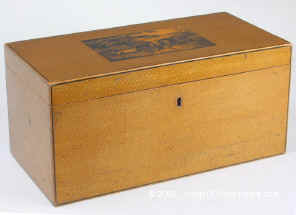
The caddy is marked overall with a penwork diamond pattern,
characteristic of early Scottish work: a feat of precision which breaks the
lightness of the wood. The centre is decorated with the figure of a man falling
from his horse with a dog in attendance or pursuit. He looks like a picture from
Scottish legend. Is he supposed to be from the pages of Walter Scott, or does
the bridge looking structure behind him suggest that he is Robert Burns Tam-O-Shanta?

This type of hinge is found
on some tea caddies and boxes but it was more usually employed in snuff
boxes. It is one thing getting a a two inch hinge to work and
look perfect. It is another to have an 11 inch.
See smallbox
144/
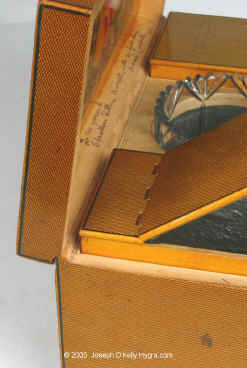
The woodwork is incredible
There are wooden hinges on both the lift-out canisters and the main
chest. All the wood is quarter-sawn for stability.
The caddy is marked overall with a penwork diamond pattern,
characteristic of early Scottish work: a feat of precision which breaks the
lightness of the wood.
|
This is from a different series of boxes to
the painted Cumnock boxes.
It results from James's Sandy's grasp of both the disciplines
of woodwork and clock making, which enabled him to develop a process for cutting
the hinges with impeccable precision.
James lived in Alyth, Perthshire in the
East side of Scotland. News of his new hinge must have traveled quite fast to Kincardineshire,
especially to Laurencekirk, which was only twenty miles North East of Alyth and
where another highly skilled craftsman, Charles Stiven, lived and worked.
It is
just possible that Stiven had found his own way of perfecting the concealed
hinge. He certainly never claimed to have done so. However, by the time of
Sandy's death, Stiven had adopted the use of this particular hinge to such an
extent, that any box fitted with it was described as a Laurencekirk box.
There are lots of photos they can be
seen in higher resolution by clicking on them. They can be viewed as a slide
show in higher resolution.
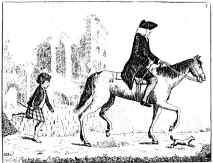
The Scottish Box with integral
wooden hinge owes its distinction to a remarkable man, James Sandy and its
existence to another remarkable man, Lord Gardenstone, here pictured by John
Kay.
|
The Scottish Box owes distinction to a
remarkable man, James Sandy and its existence to another remarkable man, Lord
Gardenstone. Its commercial viability was nurtured by a gifted craftsman,
Charles Stiven whose work this is.
James Sandy died in 1819, at the age of 53, an
acknowledged genius and a convivial man. This last quality must have been
difficult to maintain as, throughout his life, James Sandy had to fight against
tremendous odds.
Due to an accident and the inappropriate administrations of a
quack doctor, James lost the use of one of his legs, when he was a child of
twelve.
This infirmity did not deter him from busying himself making violins and
other musical instruments, in spite the fact that the only tools he had were
very rudimentary.
He triumphed over his primitive work conditions and achieved a
degree of success early on in his life.
|
Please click on images to enlarge

|
The wooden hinge is a masterpiece of woodwork.
To achieve it is one thing, but to have it survive without cracking for nearly
200 years is a masterpiece of wood art. Such a box deserves serious study.
|
The colourful group of fruit painted on the inside of the
lid contrasts with the more austere exterior. They also suggest a departure from
ancient legend to the early 19th century interest in crops both
native and exotic.
|
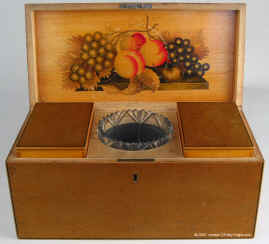
|
Please click on images to enlarge
| This caddy is stamped C. Stiven, Laurencekirk. |

|

|
C. Stiven, |
Please click on images to enlarge
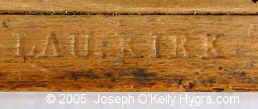
|
Laurencekirk. |
Please click on images to enlarge
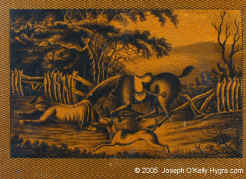
|
The centre is decorated with the figure of a man falling
from his horse with a dog in attendance or pursuit. He looks like a picture from
Scottish legend. Is he supposed to be from the pages of Walter Scott, or does
the bridge looking structure behind him suggest that he is Robert Burns Tam-O-Shanta?
|
|
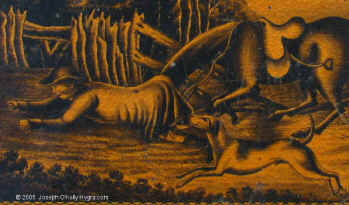
|
Inside, written with ink, is a will and testament: "To
be given to
Christien Walters (? ), with my best love kabinka (?)
Cambbell 1905"
EK has kindly sent me some observations:
"I think it starts "To
be given to Christian Walker" (not Walters)
It's very common that the lighter stroke of the round top of a capital
R fades so it looks like K. (Very like the K in Walker.)
The name "Christian" was very common for girls at this time
in Scotland, and though its "Sunday" pronunciation was
Christine, family would often just pronounce it "Kirsten /
Kirstchin".
It's hard to make out from the picture whether the bit after Robin is
either: a middle initial O or D (as in Robin O Campbell)
or else: a small "a" written across the down-and-up
flourish of the tail of the Y in the word "my"above
it.
My hunch is it's the second - in other words, Robina Campbell.
So the inscription is, I'm 95% sure,
"To be given to Christian Walker, with my best love Robina
Campbell 1905"
|
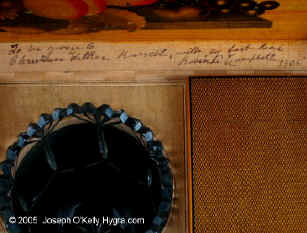
'"To be given
to" rather suggests she may have been anticipating her own demise. '
The last part of the
name of the 1905 recipient of the box.
"Christien Walters (?)"reads, I think, as Christian Walker
Russell"
(You can seen that the R in Russell and the R in "kabinka"/Robina
have faded at the top of the loop in the same way.)
|
Please click on images to enlarge
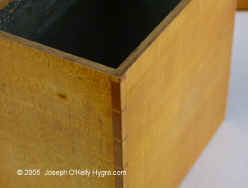
|
The immaculate dovetail joins are immaculate and
displayed. |
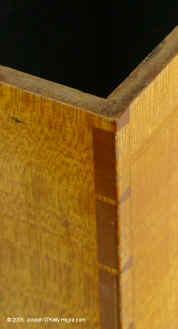
|
This is dovetailing brought to art. |
Please click on images to enlarge
| Even the Canisters have integral wooden hinges.
The understanding of wood and the ability of art craft to build this
are awe inspiring. |
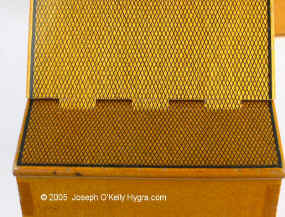
|
Please click on images to enlarge
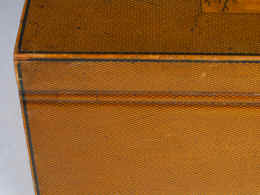
|
A
|
| The chest has a cut glass bowl. |
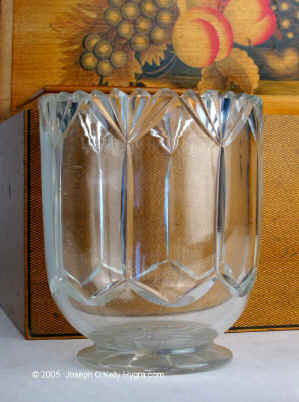
|
All text and images and linked images are ©
1999-2004 Antigone Clarke and Joseph O'Kelly. If you require any further
information on permitted use, or a licence to republish any material, email us
at copyright@hygra.com
|
